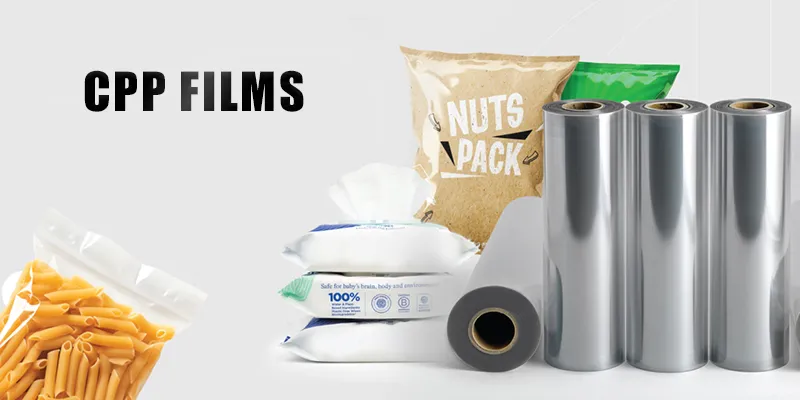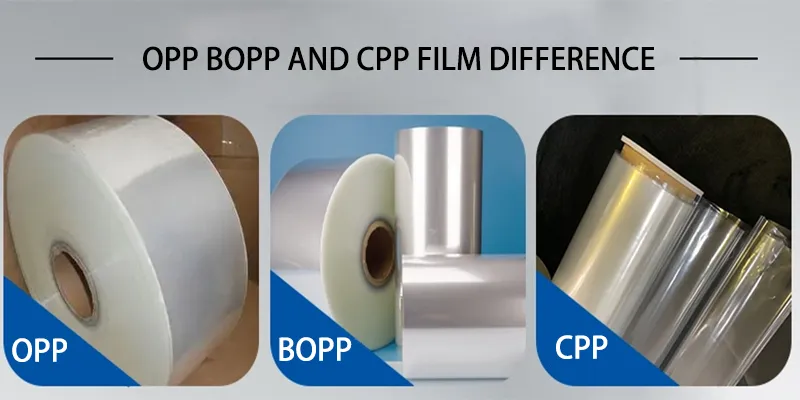What Is CPP Film
CPP film, also called cast polypropylene, is a non-stretched, non-directional plastic film. It has high transparency and uniform thickness and is generally used as a raw material for laminated materials.

Unlike BOPP film, CPP film is stretched only in the longitudinal direction and has excellent clarity and finish through rapid cooling on a cold roll.
CPP Film Types
CPP raw materials can be divided into CPP film, cpp metalized film and retort CPP film.
- Ordinary CPP film: Its density is usually 0.90-0.91 g/cm³, with a bright surface, a hard feel, and good heat-sealing performance. It is mainly used for gift packaging bags.
- Metalized CPP film: Aluminum is plated on the surface of CPP film by vacuum aluminum plating, which has the gloss brightness of metallic aluminum, excellent barrier properties, is moisture-proof and light-shielding, and is a substitute for aluminum foil.
- Retort CPP film: It is thicker than ordinary CPP film, resistant to high temperature cooking, oil-resistant, and has good airtightness. Generally, retort CPP films are used in the inner layer of meat packaging.
CPP Film Properties
CPP film has 5 main characteristics:
Durable: CPP is strong and tear-resistant. When used for packaging materials, CPP film blocks everything, protects against sunlight and moisture, and is suitable for long-term storage and protection of your products.
Recyclable: CPP film can be reused or disposable and can be recycled after use.
Safety: CPP is heat-resistant and waterproof. Unlike PVC film, CPP is more adaptable and does not release toxic gases when heated.
Biodegradable: The upstream of CPP is PP film, and PP film material belongs to biodegradable materials. Its barrier and moisture-proof properties are better, and it is the first choice for biodegradable materials.
Lamination: CPP film has high transparency, is easy to rub, and has strong heat-sealing properties. It is mostly used for the heat-sealing layer of composite flexible packaging materials and laminated with print-resistant BOPP film.
CPP Laminated Material Uses
| Film Types | Properties | Structure | Main Applications |
| Heat sealing film | Good transparency, low heat sealing temperature and fast bag making speed | BOPP/CPP | Jelly pudding packaging bags |
| Metalized Film | One side can be metalized and the other side has good heat-sealing properties. It can be used as aluminum-plastic composite packaging to save a layer of base material and reduce one composite process. | BOPP/MCPP | Puffed food bags, cereal bags, etc. |
| Retort Film | No deformation under high temperature and high pressure, elastic | PET/AL/CPPPA/AL/CPP | Roast duck bags, roast chicken bags, and other meat product packaging |
| Refrigerated CPP | CPP generally becomes brittle at low temperatures and is not suitable for refrigerated packaging. However, a new type of soft CPP has been developed that can be used for refrigeration at -18°C. | BOPP/CPP | Packaging for glutinous rice balls, dumplings, etc. that require refrigeration and display transparency |

CPP vs PE Film
- The mechanical strength and tensile strength of CPP film are higher than those of PE film.
- The CPP film density is 0.91 g/cm3, while the PE film density is 0.93 g/cm3.
- The freezing resistance of PE film is better than that of CPP film. PE film is very good at minus 18 degrees, while CPP film is very brittle at zero degrees Celsius.
- The transparency of CPP film is better than that of PE film.
- The chemical resistance of PE film is better than that of CPP film.
CPP vs OPP Film
The biggest difference between CPP and OPP film is whether the film is stretched or not. OPP uses stretching technology to enhance the performance of the film. Although CPP film is not stretched, the formula can be adjusted according to customer needs, making its application more extensive and more varied. For example, changing the color of the film, matte, glossy, anti-fog, printing, etc. Various functional PP films can be produced by different formulas.


